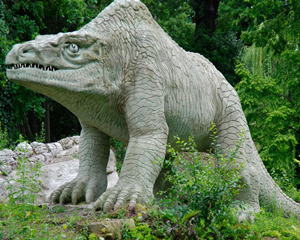On the February 20, 1824, English scientist William Buckland told the Geographical Society of London about his incredible discovery:
1824年2月20日,英国科学家威廉·巴克兰向伦敦地理学会讲述了他令人难以置信的发现:
A collection of enormous bones had been found in a quarry in Oxfordshire.
在牛津郡的一个采石场内发现了一组巨大的骨头。
From his research, William knew that these bones belonged to a very large and very old reptile.
从他的研究中,威廉了解到这些骨头出自一种非常大、非常古老的爬行动物。
"When Buckland announced Megalosaurus, he envisioned these animals as giant, overgrown lizards."
“当巴克兰宣布巨齿龙时,他把这些动物设想成是一种巨大的、过度生长的蜥蜴。”
He gave the reptile the name 'Megalosaurus', meaning 'great lizard'.
他给这种爬行动物取名为“巨齿龙”,其含义是“大型蜥蜴”。
But this is before humans knew about the existence of dinosaurs.
但这是在人类了解到恐龙的存在之前。
"In the 200 years since Buckland announced that first dinosaur, we have learned a tremendous amount about dinosaurs.
“自从巴克兰宣布发现第一只恐龙以来的200年里,我们对恐龙有了很多了解。
We now know of more than 2,000 species of dinosaurs from all over the world.
我们现在认识到了来自世界各地的2000多种恐龙。

The first ones were named and described from England, but now there's dinosaurs from every continent."
最早的恐龙是在英国命名和描述的,但现在每个大陆都有发现恐龙。”
And experts think there are many more dinosaurs in the world waiting to be found.
专家们认为世界上还有更多的恐龙等着被发现。
"And a lot of the most important new discoveries are coming from places like China and Argentina, Brazil, Mongolia, South Africa,
“许多最重要的新发现来自中国、阿根廷、巴西、蒙古、南非等地,
these enormous countries that are growing very quickly where there's many young paleontologists out looking for fossils.
这些幅员辽阔、发展迅速的国家有许多年轻的古生物学家在寻找化石。
And all of these new fossils have totally changed our perception of what dinosaurs are."
所有的这些新化石,会完全改变我们对恐龙的看法。”
The Megalosaurus that was discovered by William Buckland is now on display in the Oxford University Museum of Natural History, a reminder of where dinosaur research started all those years ago.
威廉·巴克兰发现的巨齿龙,现在在牛津大学自然历史博物馆展出,会让我们想起多年前关于恐龙研究的起点。


